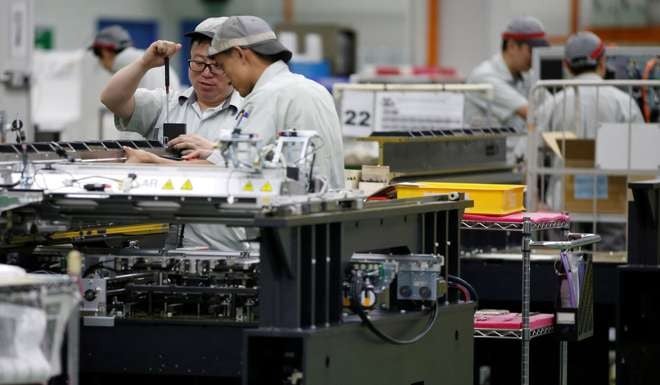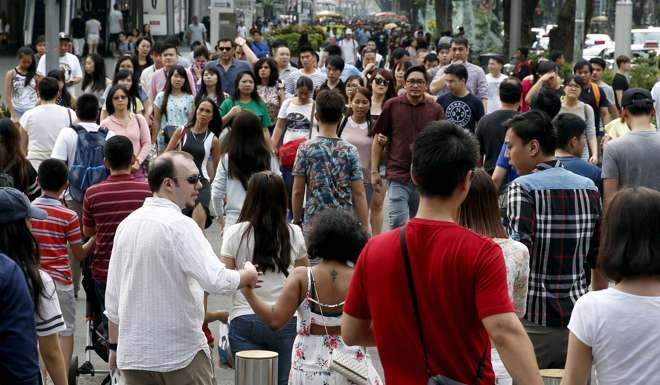- Joined
- Nov 24, 2008
- Messages
- 23,816
- Points
- 113
Once again, yet another example that you cannot put in shit useless ex SAF scholar generals to run important ministries like MITI.
After 16 years of running a small machine parts business, Singaporean businessman Leong Chan Wee finally decided to close shop earlier this year.
Business has been bad for two years, with sales trickling to a standstill but Leong held on because he didn’t know what else to do.
“We bought parts from China and sold them to precision engineering companies in the region. It was good in the late 1990s but these days it is very hard to survive,” said the 61-year-old.
“Luckily my kids have grown up, or else I wouldn’t know how to cope.”
Signs of a weak economy have been present in Singapore for some time, from near empty malls during the weekdays to restaurants shuttering up and workers finding it hard to get their jobs of choice.
 Employees at a printed circuit board assembly factory in Singapore. Signs of a weak economy have been present in Singapore for some time. Photo: Reuters
Employees at a printed circuit board assembly factory in Singapore. Signs of a weak economy have been present in Singapore for some time. Photo: Reuters
Data released by the government on Friday showed the extent of the slowdown – Singapore’s economy is heading for its poorest showing in four years.
Singapore’s Trade and Industry Ministry said on Friday the economy grew by just 0.6 per cent in the three months to September, compared with the same period last year.
But when compared to the previous quarter, the economy actually slipped 4.1 per cent, the sharpest fall since the third quarter of 2012.
Much of this bad news had already been forecast. Singapore’s Deputy Prime Minister Tharman Shanmugaratnam had earlier warned that economic growth was likely to hit the lower end of the 1 per cent and 2 per cent range.
 Lim Hng Kiang, Singapore’s Trade and Industry Minister. Photo: AFP
Lim Hng Kiang, Singapore’s Trade and Industry Minister. Photo: AFP
Trade and Industry Minister Lim Hng Kiang also said in parliament on Monday that Singapore was unlikely to fall into an “outright recession, but we cannot rule out the possibility that the economy will experience some quarters of negative growth on a quarter-on-quarter basis”.
The latest data bears this out. Manufacturing dipped 1.1 per cent on a year-on-year basis, unsurprising given the weak global demand for products such as oil and electronics, key exports for Singapore.
The services sector, which forms more than two-thirds of the economy, contracted by 0.1 per cent, probably held up by domestic consumption and decent income growth.
And if things should slip further, there is the budget, due early next year. The Singapore government has made it plainly clear that it has both the resources and the will to step in to prevent a sharp recession.
 Lawrence Wong, second left, Singpore’s Minister for National Development, is briefed on the development of Singapore's tallest building. Lifting property-cooling measures may be one way of staving off recession. Photo: AFP
Lawrence Wong, second left, Singpore’s Minister for National Development, is briefed on the development of Singapore's tallest building. Lifting property-cooling measures may be one way of staving off recession. Photo: AFP
If anything, lifting property-cooling measures or a cut in foreign worker levies, which have been rising over the past few years, will be enough to stave off the recession.
But the worry among economists is not a sharp downturn but a protracted grind to stagnation.
In the medium term, Singapore is facing weak global demand. Brexit fears are starting to bubble up again, uncertainty hangs over the US presidential elections and while China has stabilised, there is still no sign of a strong growth engine anywhere.
The central bank’s concern with growth prospects was also clear in its sombre outlook.
 People cross a road in Singapore's Orchard Road shopping district. Photo: Reuters
People cross a road in Singapore's Orchard Road shopping district. Photo: Reuters
“However, there is a continuing shift in the composition of demand towards less import-intensive consumption spending, and as a consequence, global trade in 2016 and 2017 is projected to grow more slowly than previously expected,” said the Monetary Authority of Singapore.
“Against this external backdrop, Singapore’s trade-related sectors will continue to pose a drag on GDP growth in the quarters ahead.”
After 16 years of running a small machine parts business, Singaporean businessman Leong Chan Wee finally decided to close shop earlier this year.
Business has been bad for two years, with sales trickling to a standstill but Leong held on because he didn’t know what else to do.
“We bought parts from China and sold them to precision engineering companies in the region. It was good in the late 1990s but these days it is very hard to survive,” said the 61-year-old.
“Luckily my kids have grown up, or else I wouldn’t know how to cope.”
Signs of a weak economy have been present in Singapore for some time, from near empty malls during the weekdays to restaurants shuttering up and workers finding it hard to get their jobs of choice.

Data released by the government on Friday showed the extent of the slowdown – Singapore’s economy is heading for its poorest showing in four years.
Singapore’s Trade and Industry Ministry said on Friday the economy grew by just 0.6 per cent in the three months to September, compared with the same period last year.
But when compared to the previous quarter, the economy actually slipped 4.1 per cent, the sharpest fall since the third quarter of 2012.
Much of this bad news had already been forecast. Singapore’s Deputy Prime Minister Tharman Shanmugaratnam had earlier warned that economic growth was likely to hit the lower end of the 1 per cent and 2 per cent range.

Trade and Industry Minister Lim Hng Kiang also said in parliament on Monday that Singapore was unlikely to fall into an “outright recession, but we cannot rule out the possibility that the economy will experience some quarters of negative growth on a quarter-on-quarter basis”.
The latest data bears this out. Manufacturing dipped 1.1 per cent on a year-on-year basis, unsurprising given the weak global demand for products such as oil and electronics, key exports for Singapore.
The services sector, which forms more than two-thirds of the economy, contracted by 0.1 per cent, probably held up by domestic consumption and decent income growth.
And if things should slip further, there is the budget, due early next year. The Singapore government has made it plainly clear that it has both the resources and the will to step in to prevent a sharp recession.

If anything, lifting property-cooling measures or a cut in foreign worker levies, which have been rising over the past few years, will be enough to stave off the recession.
But the worry among economists is not a sharp downturn but a protracted grind to stagnation.
In the medium term, Singapore is facing weak global demand. Brexit fears are starting to bubble up again, uncertainty hangs over the US presidential elections and while China has stabilised, there is still no sign of a strong growth engine anywhere.
The central bank’s concern with growth prospects was also clear in its sombre outlook.

“However, there is a continuing shift in the composition of demand towards less import-intensive consumption spending, and as a consequence, global trade in 2016 and 2017 is projected to grow more slowly than previously expected,” said the Monetary Authority of Singapore.
“Against this external backdrop, Singapore’s trade-related sectors will continue to pose a drag on GDP growth in the quarters ahead.”




